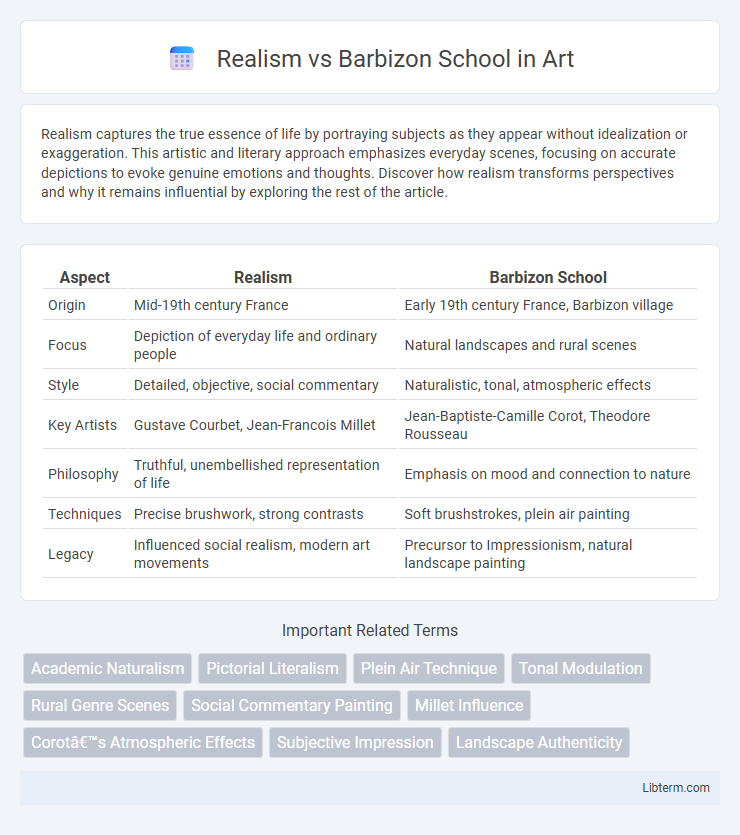Realism captures the true essence of life by portraying subjects as they appear without idealization or exaggeration. This artistic and literary approach emphasizes everyday scenes, focusing on accurate depictions to evoke genuine emotions and thoughts. Discover how realism transforms perspectives and why it remains influential by exploring the rest of the article.
Table of Comparison
| Aspect | Realism | Barbizon School |
|---|---|---|
| Origin | Mid-19th century France | Early 19th century France, Barbizon village |
| Focus | Depiction of everyday life and ordinary people | Natural landscapes and rural scenes |
| Style | Detailed, objective, social commentary | Naturalistic, tonal, atmospheric effects |
| Key Artists | Gustave Courbet, Jean-Francois Millet | Jean-Baptiste-Camille Corot, Theodore Rousseau |
| Philosophy | Truthful, unembellished representation of life | Emphasis on mood and connection to nature |
| Techniques | Precise brushwork, strong contrasts | Soft brushstrokes, plein air painting |
| Legacy | Influenced social realism, modern art movements | Precursor to Impressionism, natural landscape painting |
Introduction to Realism and the Barbizon School
Realism emerged in the mid-19th century as an art movement emphasizing accurate, unembellished depictions of everyday life and ordinary people, rejecting Romantic idealization. The Barbizon School, active primarily between 1830 and 1870 in France, focused on naturalistic landscape painting rooted in direct observation of the Fontainebleau Forest. Both movements significantly influenced modern art by promoting truthful representation and pioneering plein air techniques.
Historical Context and Emergence
The Realism movement emerged in mid-19th century France as a response to Romanticism, emphasizing accurate, unidealized depictions of everyday life and social realities during the Industrial Revolution. The Barbizon School, founded earlier in the 1830s near the Forest of Fontainebleau, preceded Realism by focusing on natural landscapes and plein air painting, influencing the transition toward more truthful representations of nature. Both movements played critical roles in shifting art from imaginative subjects to observational authenticity amid changing social and economic conditions in 19th-century Europe.
Key Philosophies and Artistic Goals
Realism emphasizes accurate, unembellished depiction of everyday life, aiming to portray subjects with truthful detail and social significance. The Barbizon School prioritizes naturalism, focusing on capturing the atmospheric effects and mood of rural landscapes through direct observation. While Realism often highlights social issues and human experiences, the Barbizon School seeks to evoke emotional resonance with nature's beauty and simplicity.
Notable Artists and Leading Figures
Realism's notable artists include Gustave Courbet, who emphasized everyday scenes and social issues with raw honesty, and Jean-Francois Millet, known for his detailed depictions of rural labor. The Barbizon School, centered in the forest of Fontainebleau, featured leading figures like Theodore Rousseau and Jean-Baptiste-Camille Corot, pioneers of plein air painting and naturalistic landscapes. Both movements significantly influenced 19th-century art by shifting focus from idealized subjects to more authentic representations of life and nature.
Techniques and Materials Used
Realism employed precise brushwork and a palette dominated by earth tones to capture everyday scenes with photographic clarity, emphasizing natural light and shadow effects. The Barbizon School favored looser, more expressive brushstrokes and softer, muted colors, often utilizing plein air techniques to depict the French countryside's atmospheric conditions directly. Both movements incorporated oil paints on canvas but differed in their approach to texture and detail, with Realism prioritizing exactitude and the Barbizon School embracing mood and naturalism.
Treatment of Nature and Everyday Life
Realism emphasizes a truthful, unembellished representation of everyday life and nature, capturing ordinary scenes with precise detail and social context. The Barbizon School focuses on natural landscapes with a romanticized yet direct observation, highlighting light and atmosphere in rural settings. Both movements reject idealization but differ as Realism centers on social realities while Barbizon artists prioritize harmonious interaction with untouched natural environments.
Influence on Landscape Painting
Realism revolutionized landscape painting by emphasizing accurate, unidealized depictions of nature, capturing everyday rural life and the environment with precise detail and social context. The Barbizon School, emerging earlier in mid-19th century France, pioneered the move toward naturalism by painting en plein air and focusing on mood, atmosphere, and the changing effects of light within forest scenes around Fontainebleau. Together, these movements laid the groundwork for modern landscape art by shifting the focus from classical, idealized landscapes to truthful representations grounded in observation and emotional resonance.
Major Works and Iconic Examples
Realism features major works like Gustave Courbet's "The Stone Breakers" (1849) and Jean-Francois Millet's "The Gleaners" (1857), emphasizing everyday life and social realities with detailed, unidealized depictions. The Barbizon School, centered around nature, is exemplified by Theodore Rousseau's "The Forest of Fontainebleau" (1849-1851) and Jean-Baptiste-Camille Corot's "Ville d'Avray," capturing landscapes with a poetic, naturalistic approach. These iconic examples illustrate Realism's focus on human experience and social commentary, contrasting with the Barbizon School's pioneering plein air techniques and intimate natural scenes.
Critical Reception and Legacy
Realism emerged in mid-19th century France, championing accurate depictions of everyday life and society, and challenged Romantic idealism, receiving both praise for its truthful portrayal and criticism for perceived starkness. The Barbizon School, centered in the Forest of Fontainebleau, emphasized naturalistic landscape painting and mood, influencing Impressionists and earning acclaim for its atmospheric, plein-air techniques. Both movements significantly shaped modern art, with Realism paving the way for social commentary in painting, while the Barbizon School contributed to the development of landscape art and the broader shift toward naturalism.
Lasting Impact on Modern Art
The Realism movement fundamentally reshaped modern art by emphasizing truthful, unidealized depictions of everyday life, influencing genres such as social realism and paving the way for movements like Impressionism. The Barbizon School's focus on naturalistic landscape painting and plein air techniques contributed significantly to the development of modern landscape art and inspired future movements such as Impressionism and Post-Impressionism. Both movements collectively advanced the shift toward capturing contemporary life and nature with honesty and direct observation, laying crucial groundwork for 20th-century artistic innovations.
Realism Infographic

 libterm.com
libterm.com